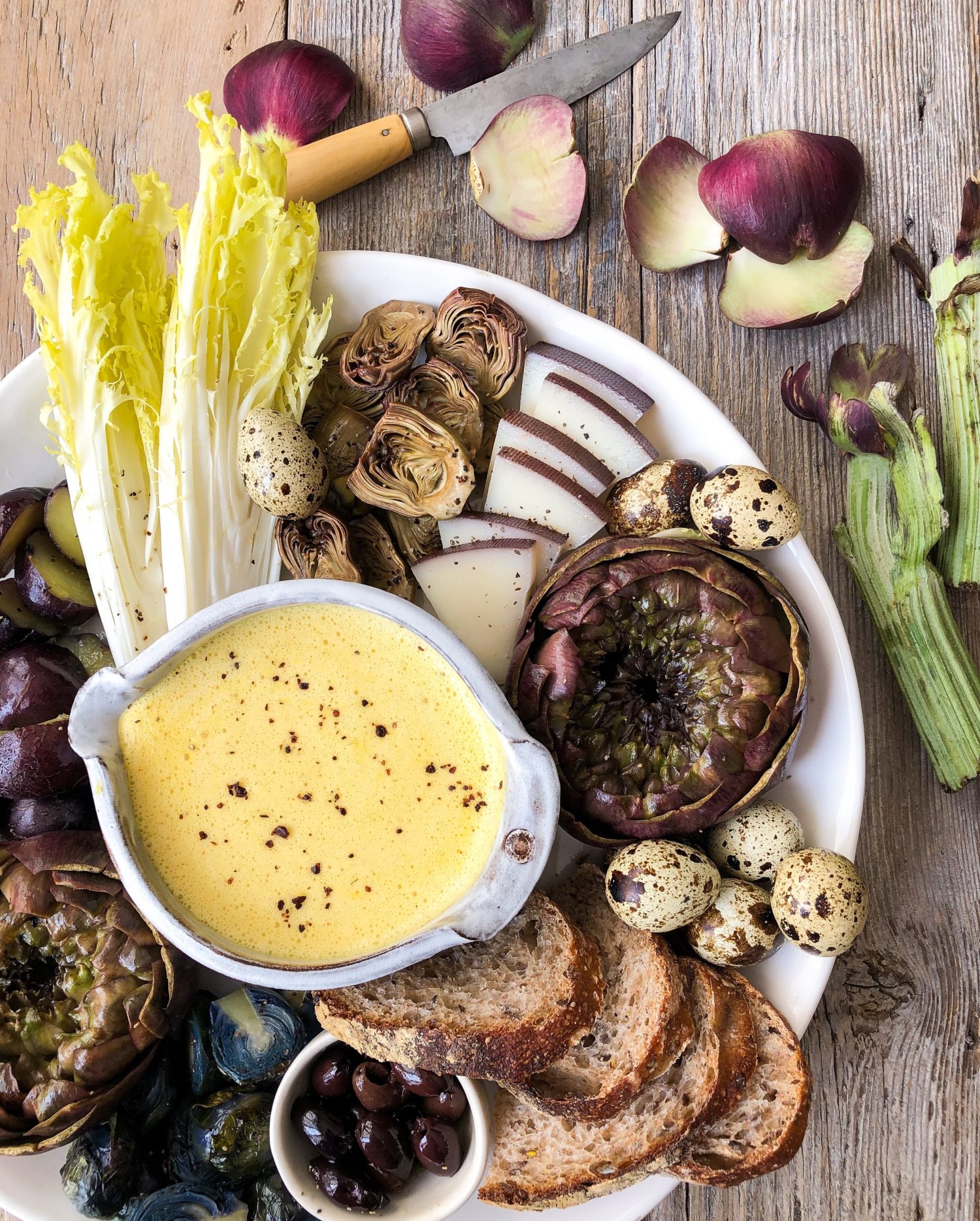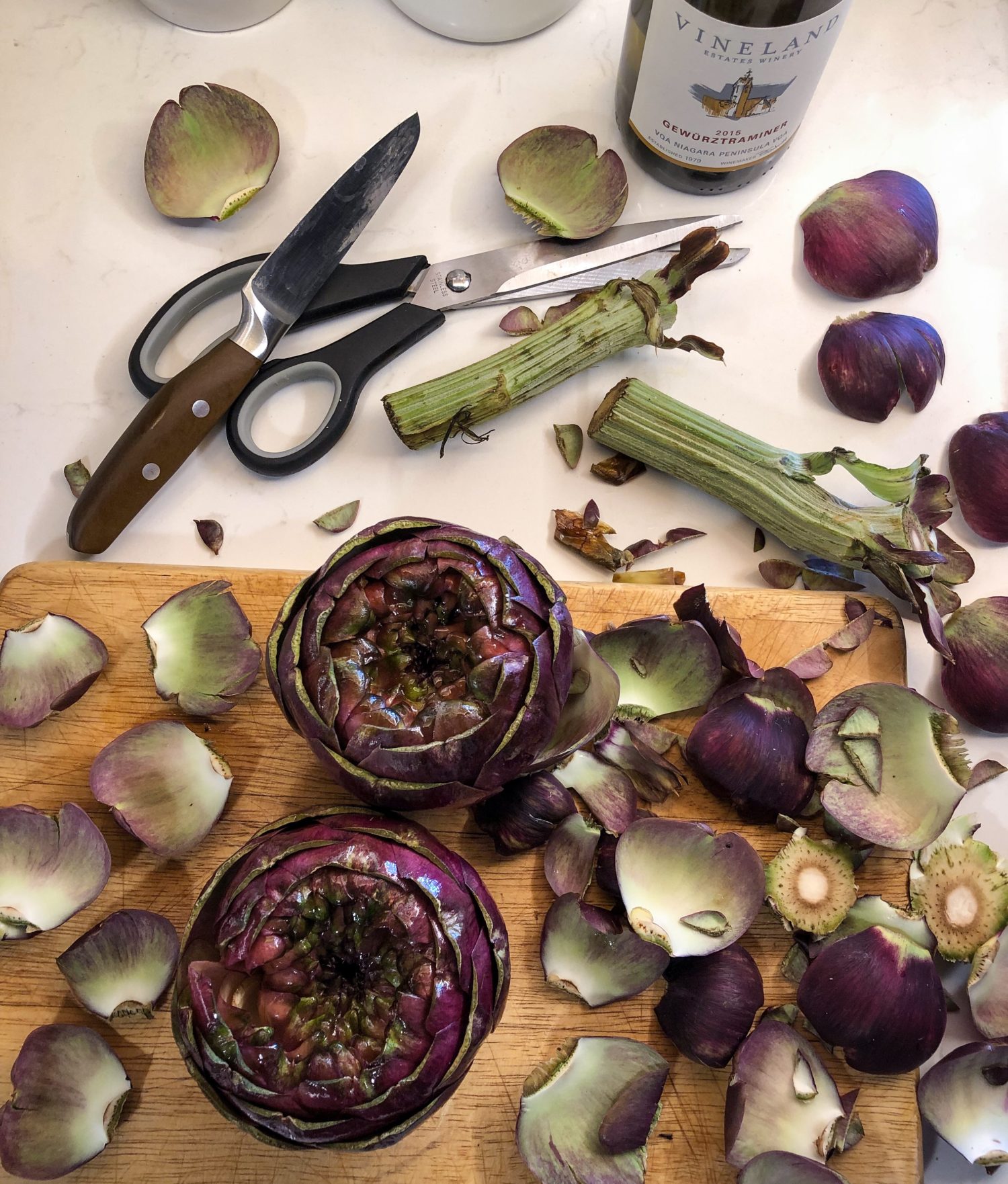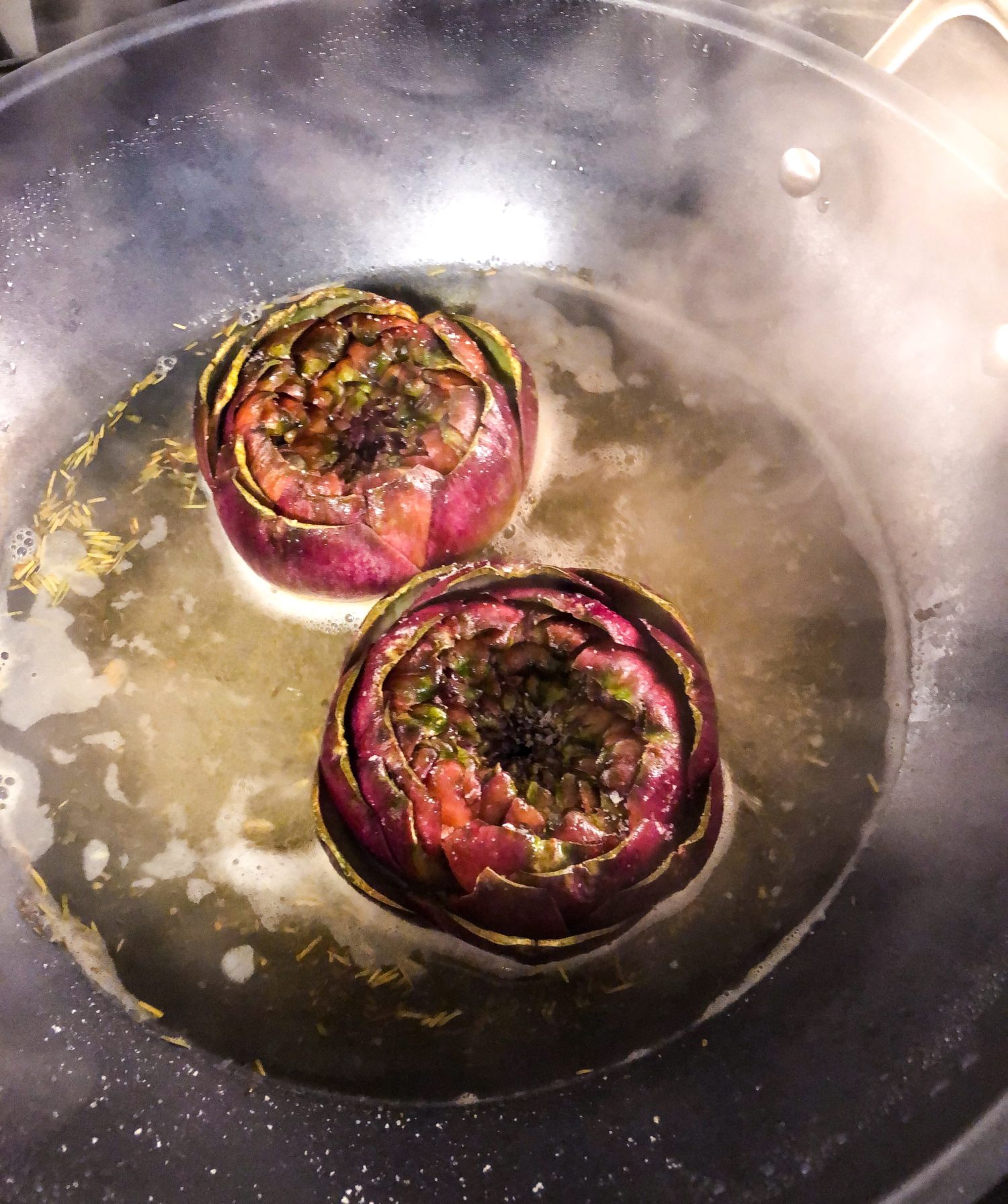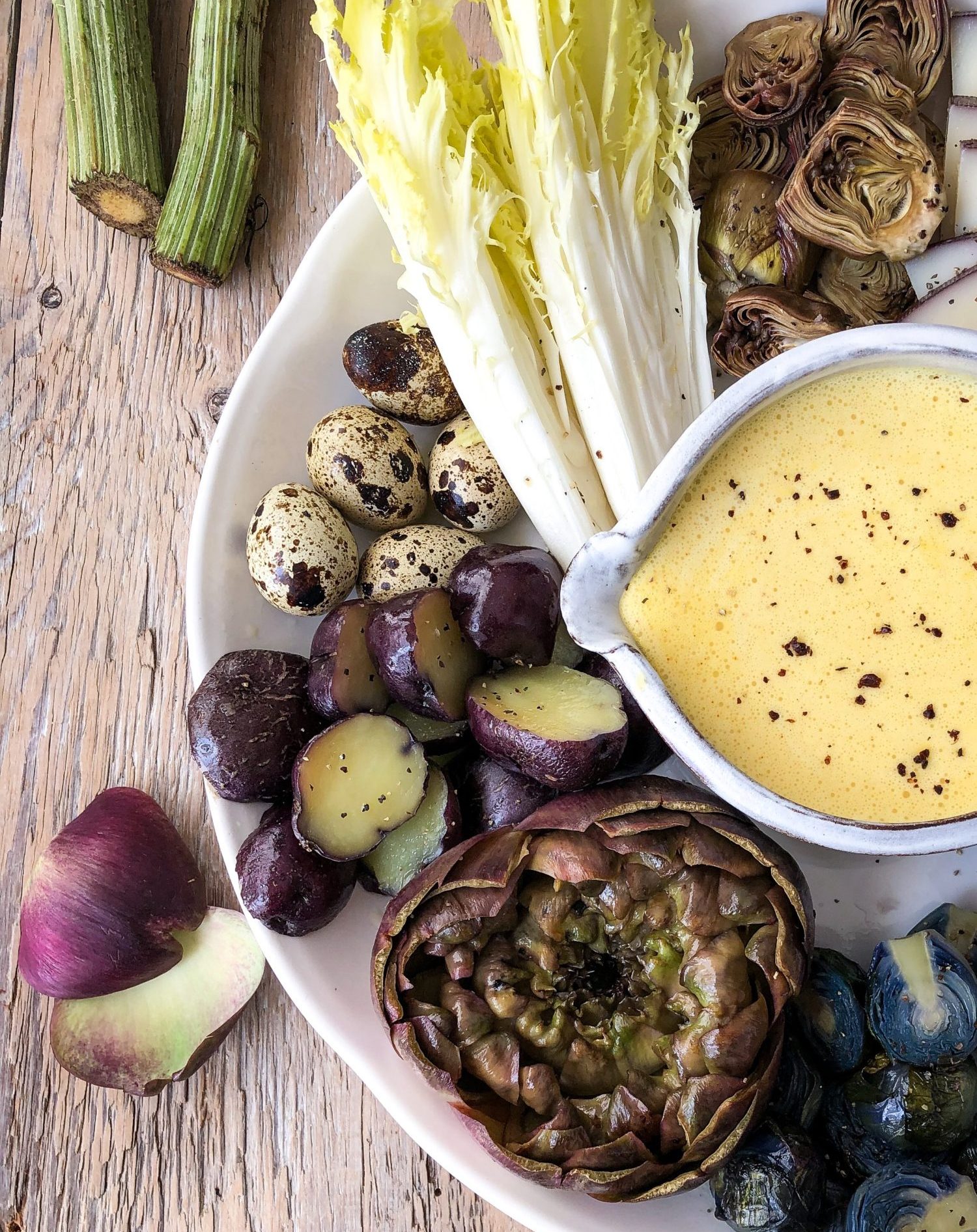Growing up, one of our favourite times around the dinner table involved the lowly, rather alien-looking artichoke.
The First Vegetable I Considered Alien!
I never questioned this bizarre looking vegetable: it was a yearly treat since my mom commonly prepared them when they were in season. But I do remember as a teenager, having a friend see them for the first time and calling them alien food. What was that supposed to mean? He said, it looks like something that some alien creature on Star Trek would be eating. Really? (I think he was just a Trekkie and used that as his benchmark for life) I didn’t see it. But I guess I do now. I can look at the prickly orb and admit that it does look at tad strange.
Mama Served Artichokes the French Way
For us, it was a total treat to find out that Mama was steaming artichokes and preparing her special sauce for it. I didn’t know hollandaise from Kool-Aid, but I did know I loved the sauce. She would set out a platter of these full globes, with their prickly points there to impale our fingers if we weren’t careful. I don’t remember her always trimming them, but I’m sure she did (I can’t imagine she’d let us little kids around such weaponry. Have you ever pierced yourself with an artichoke leaf? It smarts!)
One by one, we would pull those leaves off the globe, dip it into some of the sauce, and then slide it into our mouths, scraping the soft flesh with our teeth. Working our way around the globe, building up a larger and larger pile of scraped leaves on the plate, we would eventually find the leaves getting softer and softer, with more flesh to savour. And then we’d hit the choke. She taught us how to scrape away the fuzz (nasty for little kids and big kids alike) to reveal the gem at the centre. The artichoke heart. It was so soft, it was creamy! We would cut it into four pieces, and using our forks, would dip each piece into the sauce and then pop it into our eager mouths. Oh yummy! Our hard work had paid off. If the artichoke was large enough, with that sauce, it was dinner. So rich, that there was rarely room for anything else in our happy tummies.

I still get giddy thinking about preparing them now. Jim had never seen an artichoke presented this way. But he has come around. He’s not a dip guy, but if I prepare a heated garlic butter and drizzle it over before presenting it to him, he gladly pulls leaf after leaf, scraping off the flesh just like we did as kids.
When I saw that ‘The Broad Fork‘, a fantastic book dedicated to fun ways to cook and prepare fruit and veg, included a Simmered Artichoke recipe, I just couldn’t resist. Hugh Acheson‘s recipe for the simmering liquid is beyond a simple water bath. He uses broth, onions, and thyme to add a great flavour to the final artichokes. I loved this version.
I still like to braise my artichokes in a wok, It’s the way that also works for me. And steaming artichokes in a pot with a steamer basket is always the easy way. I’m going to share all versions here for you to choose from.
Artichoke Prep
To prep artichokes for steaming, braising or boiling, there are just a few steps. First you are going to cut off the top half inch or so of the leaves. Then you will pull off about 2-3 layers of the outer leaves. These are tougher, and no matter how long they are cooked, they will not soften to becoming edible. Then cut off any of the exposed stem. Finally you will take a pair of scissors and trim away the spiny barbs at the top of all the outer leaves. The inner leaves aren’t as dangerous!
Pull the leaves open gently with your fingers, and season with salt. Then drizzle olive oil over them. Now they are ready to go into whatever pot you have prepared, whether it is to boil, steam or braise them. Each process is described in the recipe card below.


Hollandaise Sauce
This is my go-to, no need for a blender, recipe. It always works, and has a bright lemony flavour. It actually starts with chopped shallots and white wine (I have been known to use champagne if I am out of white wine!) Cook them both in a small pot over high heat till reduced by half. Then remove the shallots which have done their job of flavouring the wine. You will add butter and stir it till it is almost melted. Reduce the heat to medium low and add the egg yolks. Whisk constantly till blended and thickened. Flavour with salt, pepper, cayenne and lemon juice. Keep it warm in a thermos or insulated travel mug till needed. See my Hollandaise Sauce at work with Egg Benedict, or my savoury Spring Brunch Crepes.
I hope you all try artichokes this way, they are always an early spring treat for me!
Love Jen


BRAISED ARTICHOKES WITH HOLLANDAISE SAUCE
Ingredients
SIMMERED ARTICHOKES
- 7 tbsp unsalted butter
- 1 cup sliced yellow onion
- 1 tbsp fresh thyme leaves
- ¼ cup fresh flat-leaf parsley leaves
- 2 large globe artichokes , top 2 inches sliced off
- 1 cup dry white wine
- Kosher salt
- 1 lemon , cut into wedges
BRAISED ARTICHOKES
- 2 cups dry white wine
- 1 cups water
- 1 lemon, juiced
- 2 tsp dry oregano
- 2 tsp dry rosemary
STEAMED ARTICHOKES
- 1 lemon, sliced
- 1 bayleaf
- 1/3 cup fresh parsley
- 2 medium artichokes
HOLLANDAISE SAUCE
- 2 medium shallots, chopped
- 1/2 cup white wine
- 8 tbsp salted butter
- 1/2 tsp lemon juice
- 2 egg yolks
- 1/4 tsp kosher salt or more to taste
- 1/4 tsp white pepper or more to taste
- 1/4 tsp cayenne pepper start with less and taste
Instructions
ARTICHOKE PREP
-
Tear off the first few layers of outer leaves from the bottom of each artichoke, as well as any attached to the stem. Then take a knife to cut off the exposed stem, thus creating a base so that the artichokes can stand up.
-
Use a pair of scissors to cut away the barb portion of all the outer leaves. These are very sharp, and it is worth taking the time to remove them. Having said that, we grew up with them attached, and I am still alive to talk about it!!
-
Use a sharp knife to cut away the top half inch or so of the artichoke. This should remove any of the final barbs or tough bits.
-
Gently pull the leaves open with your fingers, and sprinkle the insides with a little salt. Drizzle with olive oil. Now they are ready for whatever method you will cook them.
SIMMERING THE ARTICHOKES
-
Place a stockpot over low heat and melt 1 tablespoon of the butter in it. Once the butter starts to foam, add the onion, half of the thyme, and the parsley, and begin to sweat the onion. While you prepare the artichokes, the onions will happily hang out over low heat.
-
Add the artichokes to the pot, standing up. Then add the white wine and enough water to cover the artichokes. Bring to a boil over high heat, add enough salt to make the liquid pleasantly salty, and then lower to a simmer. To keep them submerged, place a plate that’s just small enough to fit inside the pot over the artichokes. Cover the pot with a lid and cook the artichokes for about 20 minutes, or until you can slide a knife into the base with no resistance. This will depend on the size of artichokes you are using.
-
Remove the plate and then the artichokes from the liquid, and place the artichokes on a cutting board to cool. I usually use tongs, so that I can tip the artichoke upside down over the pot to drain out any water that got caught inside the leaves.
BRAISING THE ARTICHOKES
-
Combine the wine, water, lemon juice, salt and herbs in a wok or large dutch oven. You want enough liquid to cover the wider wok, and go up halfway the artichokes once they are added in. If not, add some more water. Using a wok will actually allow you to prepare 3-4 at one time, depending on the size. Bring to a boil.
-
Place the prepared artichokes into the liquid. Cover and reduce the heat to a rolling simmer. Gently braise until softened. Depending on the size of the artichokes, this can take anywhere from 30 minutes to 45 minutes.
-
Test by pushing a knife into the centre. If there is no resistance, they are ready.
-
Remove with tongs and drain on paper towel lined plate by tipping them over gently to let any water flow out.
STEAMING THE ARTICHOKES, the easiest method
-
Place lemon slices, a bay leaf, and handful of chopped parsley at the bottom of a pot which can hold a steamer basket, the artichokes, and the lid still seal well.
-
Pour in 2-3 inches of water, and then place the steamer basket into the pot. Place the prepared artichokes (see above) into the basket. Cover with the lid.
-
Bring to a boil, reduce heat to medium, and cook till tender (a knife should slide easily into the bottom and up into the flesh) This can take 30 or so minutes, depending on the size of your artichokes. Refill with water as needed.
HOLLANDAISE SAUCE
-
Combine the shallots and white wine in a small pot over high heat. Cook till the liquid is reduced by just over half. Strain through a small mesh strainer, discarding the shallots, and returning the three tablespoons of wine to the pot.
-
Add the cubed butter and stir till almost melted.
-
Reduce the heat to medium low, add the lemon juice and whisk everything briskly to get the fats and water to blend seamlessly. Add the two egg yolks and continue whisking firmly till thickened, about 2 minutes. Watch the heat, if it is thickening to quickly, the eggs may start to scramble. You can even lift the pot off the heat to help out. If on the other hand it isn't thickening, you may need to increase heat.
-
Season with about 1/4 tsp of salt and pepper and a pinch of cayenne. Taste and re-season if needed. I like a bit more lemon, so this is also a good time to add a splash more.
-
You can also garnish with a good pinch of sumac (it works wonderfully with the lemon and the eggs!) or more traditional chives, thyme or tarragon.
To Serve
-
Place the drained tender artichokes on a serving platter, with the Hollandaise Sauce in a small bowl beside it.
-
Working from the outside, pull of one leaf at a time, dip it into some hollandaise and scrape the flesh with your teeth. The outer leaves will have the bare amount of 'flesh'. But as you work in, the leaves get softer and more fleshy. You will eventually get to where the leaves pull off in bunches.
Then you will see a fuzzy part, which is called the “choke.” Using a small spoon or knife, remove the choke. You will be left with the heart, the most tender prize of the artichoke. I usually cut this into a few pieces and with a fork dip them into the sauce.
Recipe Notes
Simmered Artichokes adapted from The Broad Fork: Recipes for the Wide World of Vegetables and Fruits


Leave a Reply